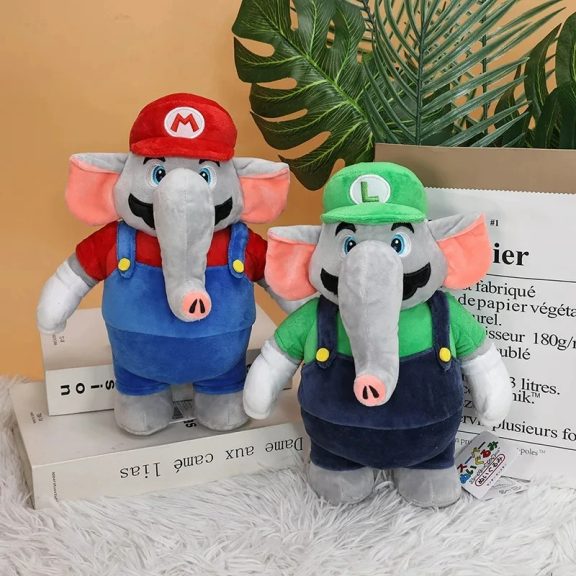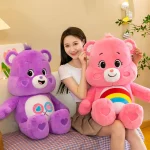Plush dolls have been cherished by people of all ages for centuries. From toddlers clutching a beloved stuffed animal to adults who collect intricately designed plush figures, these soft, comforting companions transcend cultural boundaries and generations. The evolution of plush dolls from simple handmade toys to highly sought-after collectibles in modern times is a testament to their enduring popularity. In this article, we’ll explore the history of plush dolls, their emotional and developmental benefits, the various types available today, and their continued relevance in contemporary society.
A Brief History of Plush Dolls
Plush , also known as stuffed animals or soft toys, have a long and rich history that dates back to ancient civilizations. The first documented plush toys were found in ancient Egyptian tombs, where they were made of leather and filled with straw or other natural materials. These early examples served both as playthings and ritual objects.
However, the modern doll as we know it began to take shape in the late 19th and early 20th centuries. In 1880, a German company called Steiff, founded by Margarete Steiff, started producing plush animals made from felt and mohair. Steiff’s company became famous for creating the first commercially produced teddy bear in 1902, which remains an iconic symbol of plush dolls to this day.
Over the years, dolls have become more than just toys. They have taken on roles in popular culture, advertising, and as collectibles. The development of new materials, such as synthetic fibers and polyester stuffing, has made plush dolls more affordable and durable, allowing them to become an integral part of childhood worldwide.

The Emotional and Developmental Benefits of Plush Dolls
One of the most significant reasons dolls remain so popular is their ability to provide emotional comfort. From a very young age, children often form strong attachments to plush toys, treating them as confidants or companions. These dolls serve as transitional objects, helping children navigate the emotional challenges of growing up, such as separation anxiety or adjusting to new environments. The soft texture and cuddly nature of plush dolls provide a sense of security and reassurance.
For many children, plush dolls play a vital role in imaginative play, a critical aspect of early childhood development. Imaginative play, in which children create scenarios and stories involving their dolls, helps them develop social, cognitive, and emotional skills. Through this type of play, children learn to express their emotions, practice problem-solving, and develop empathy by imagining how their dolls might feel.
In addition to their role in emotional development, dolls also offer sensory benefits. Many plush toys are designed with different textures and features, such as soft fur, smooth plastic eyes, or crinkly fabrics, that stimulate a child’s sense of touch. These tactile experiences are essential for sensory development and can also be soothing for children who might feel overwhelmed or anxious.
The Appeal of Plush Dolls for Adults
While dolls are often associated with childhood, their appeal extends well beyond the early years. Many adults continue to enjoy dolls for a variety of reasons, including nostalgia, collecting, and as stress-relief tools. For some, plush dolls serve as sentimental reminders of childhood memories or loved ones. Holding onto a cherished plush doll from childhood or receiving one as a gift can evoke feelings of warmth and comfort.
In recent years, the trend of doll collecting has grown significantly. Collectors seek out rare or limited-edition plush dolls, often from popular brands or franchises such as Disney, Sanrio (the makers of Hello Kitty), or Beanie Babies, which sparked a collecting craze in the 1990s. These dolls, often meticulously crafted and featuring intricate designs, can become highly valuable and are treated as prized possessions among enthusiasts.
Moreover, dolls have gained popularity as stress-relief tools for adults. The act of hugging or holding a soft, plush object can trigger the release of oxytocin, a hormone that promotes relaxation and reduces stress levels. In fact, many adults find comfort in keeping a small doll at their desk at work or in their living space as a way to alleviate anxiety during hectic moments.

The Different Types of Plush Dolls
The variety of dolls available today is vast, catering to a wide range of preferences and interests. Some of the most popular categories include:
1. Teddy Bears
Perhaps the most iconic doll, the teddy bear, has been a staple of childhood for over a century. Teddy bears come in various shapes, sizes, and designs, from traditional brown bears with button eyes to more modern interpretations featuring colorful patterns or themed clothing. Teddy bears are often gifted for special occasions, such as birthdays, holidays, or as comforting gifts during times of hardship.
2. Character Plush Dolls
Many dolls are designed to resemble popular characters from movies, television shows, or video games. Brands like Disney, Marvel, and Pokémon have capitalized on the popularity of their franchises by creating plush versions of beloved characters. These plush dolls are especially popular among fans of all ages, who enjoy owning soft, huggable versions of their favorite heroes, villains, and creatures.
3. Custom and Handmade Plush Dolls
For those looking for something more personal or unique, custom and handmade dolls offer a one-of-a-kind option. Artisans and small businesses often create custom dolls that can be tailored to resemble a person’s likeness, a pet, or an original design. Handmade dolls are highly valued for their craftsmanship and attention to detail, making them perfect as personalized gifts or keepsakes.
4. Animal-Themed Plush Dolls
Animal-themed dolls are a popular choice among children and adults alike. From traditional farm animals like cows and pigs to exotic creatures like lions, pandas, or even dinosaurs, animal plush dolls offer endless possibilities for imaginative play and collecting. Many children form strong bonds with their favorite animal doll, treating it as a trusted companion throughout their formative years.
5. Kawaii Plush Dolls
Originating in Japan, the “kawaii” (cute) aesthetic has influenced the design of many plush dolls. Kawaii plush dolls often feature exaggeratedly adorable designs with large eyes, pastel colors, and soft, rounded shapes. Brands like Sanrio, known for Hello Kitty, and characters from the world of anime and manga are often created in this style, making them highly popular among fans of Japanese pop culture.
Plush Dolls in Popular Culture and Media
Plush dolls have not only maintained a presence in homes and toy stores but have also become prominent figures in popular culture and media. From iconic brands like Build-A-Bear, where customers can create their personalized plush dolls, to characters like Winnie the Pooh and Paddington Bear who have become literary and cinematic legends, dolls are deeply ingrained in our collective consciousness.
The role of plush dolls in media goes beyond fictional characters. In the digital age, dolls have found new life through social media platforms where fans share photos and stories of their favorite plush companions. Instagram, for instance, has numerous accounts dedicated to “plush photography,” where plush dolls are posed in various real-life scenarios, creating whimsical and heartwarming content.
Moreover, plush dolls have taken on therapeutic roles in certain settings. Hospitals, schools, and mental health clinics often use plush dolls as part of therapeutic practices, helping patients, especially children, cope with illness, trauma, or anxiety.
The Future of Plush Dolls
As technology continues to evolve, the future of plush dolls looks bright. Innovations such as interactive plush dolls, equipped with sensors and voice recognition technology, are becoming more common. These interactive toys can respond to touch, movement, or voice commands, offering a more engaging experience for children. While some may worry that technology could overshadow traditional plush dolls, the timeless appeal of a soft, cuddly companion is unlikely to fade.
Additionally, sustainability has become a growing concern in the production of dolls. Many manufacturers are now exploring eco-friendly materials, such as organic cotton or recycled stuffing, to reduce the environmental impact of doll production. This shift towards more sustainable practices reflects a broader trend in the toy industry and ensures that plush dolls will continue to be a beloved companion for future generations.
Conclusion
Plush dolls hold a special place in the hearts of people young and old. Whether they serve as a source of comfort, a collectible item, or a tool for imaginative play, dolls have a unique ability to evoke feelings of warmth, security, and joy. Their enduring popularity, combined with their versatility and evolving designs, ensures that plush dolls will continue to be a cherished part of our lives for many years to come.



